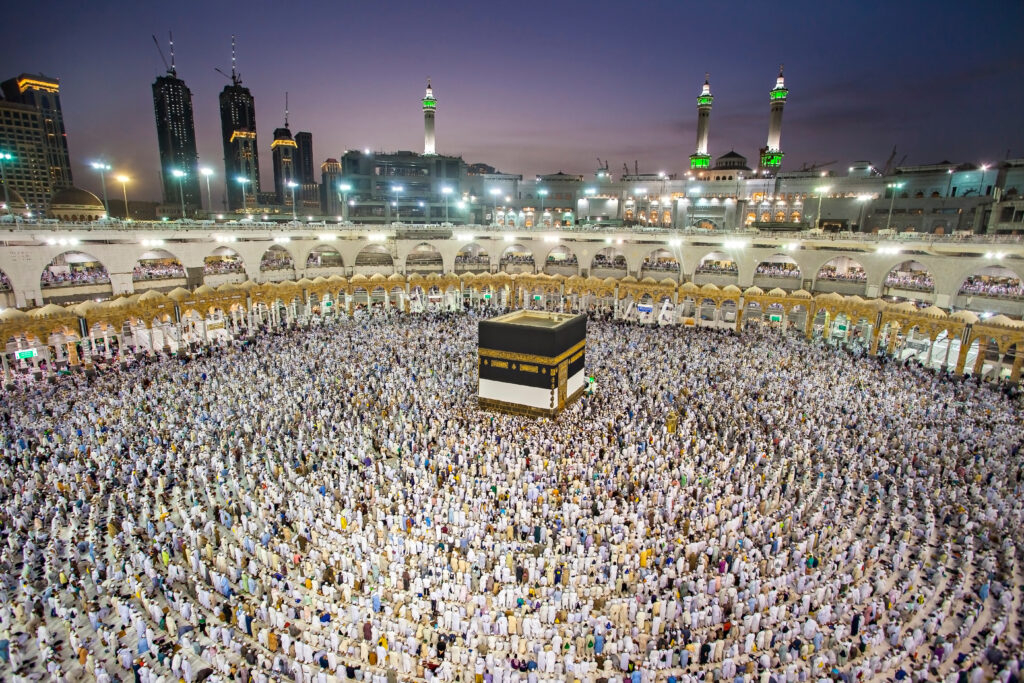What is Hajj?
Each year, millions of Muslims embark on the Hajj pilgrimage. But what exactly is Hajj?
Hajj is the Islamic pilgrimage to the holy city of Mecca, Saudi Arabia. It is one of the five pillars of Islam, which are mandatory acts of worship for Muslims.
Hajj occurs annually during the Islamic month of Dhu al-Hijjah, and it is obligatory for every adult Muslim who is physically and financially capable of undertaking the journey at least once in their lifetime.
When is Hajj 2024?
The Hajj pilgrimage for 2024 is expected to start on Friday, June 14th and end on Wednesday, June 19th. Note: These are approximate dates based on the Lunar Islamic calendar.
How to Perform Hajj
During Hajj, pilgrims perform a series of rituals that commemorate the actions of the Prophet Ibrahim and his family. These rituals include:
- Ihram: Pilgrims enter into a state of Ihram. This entails wearing simple white garments, symbolising equality, purity, and the start of their spiritual journey.
- Tawaf: Pilgrims circle around the Kaaba seven times, while reciting prayers and supplications.
- Sa’i: Pilgrims walk between the hills of Safa and Marwa seven times. This commemorates Hajar’s search for water for her son Ishmael.
- Wuquf at Arafat: Pilgrims gather at the Plain of Arafat. This is where they stand in prayer and supplication, seeking forgiveness and spiritual renewal.
- Muzdalifah: Pilgrims then spend the night at Muzdalifah. This is where they engage in prayers and collect pebbles for the ritual of stoning the pillars.
- Ramy al-Jamarat: The next step is stoning the pillars. This symbolises the rejection of temptation and evil, as demonstrated by Prophet Ibrahim’s stoning of Satan.
- Animal Sacrifice (Qurbani): The sacrifice of an animal is taken place, It is typically a sheep, goat, cow, or camel. This is symbolic of Prophet Ibrahim’s willingness to sacrifice his son as an act of obedience to God.
- Halq or Taqsir: Pilgrims then either shave their heads (Halq) or trim their hair (Taqsir). This is a process for purification and the casting off of worldly attachments.
- Tawaf al-Ifadah: Return to Kaaba to perform tawaf, followed by Sa’i between Safa and Marwa. This marks the completion of Hajj rites.
- As the pilgrimage nears its end, pilgrims participate in the final act of stoning the three pillars: Al Ula, Al Wusta, and Al Aqaba.
- Tawaf al-Wida: To conclude, before leaving Mecca, pilgrims perform a farewell tawaf around the Kaaba.
Tips for Hajj
- Before your trip, ensure that you familiarise yourself with the rituals of Hajj. This will ensure that you are able to make the most of your trip. Most countries have local communities and Islamic centers that offer workshops and educational programs to help prepare pilgrims for Hajj. These workshops provide valuable information. They often cover practical tips, religious guidance, and detailed explanations of the Hajj rites, so be sure to look out for these opportunities!
- Prepare physically by starting to walk, as Hajj involves around 5km -15km per day. Begin incorporating walking into your daily routine to build stamina and endurance. This physical preparation will help you navigate the extensive walking required during Hajj. This will ensure you can comfortably participate in the experience without fatigue.
- Compile a list of supplications (dua’s) to recite throughout your pilgrimage. These dua’s can include personal requests, expressions of gratitude, and prayers for guidance and forgiveness. Having a prepared list will help you stay focused and spiritually connected throughout the journey.
- Manage your expectations! Hajj often involves a significant amount of waiting which is not usually anticipated. Understand that Hajj involves large crowds and long wait times for various rituals.
- Ensure that you prepare mentally for these delays and approach them with patience and a positive mindset. Remember that this is just an integral part of the Hajj experience. In this time, you can use your dua list to supplicate, to make use of your time.
- When packing, include essentials such as wudu socks, wudu bottle caps, electrolytes, protein packs, and suitable footwear like washable plastic sandals and sock trainers. Ensure you opt for breathable clothing due to hot weather. Pack thoughtfully, considering the specific needs and challenges of the Hajj pilgrimage.
Hajj is a beautiful journey and for the majority, a once in a lifetime experience. To fully immerse yourself, you will want to ensure you are well equipped and prepared to make the most of this experience, and do it correctly. By following these tips and preparing thoughtfully for Hajj, you can ensure that your trip is worthwhile and meaningful.

